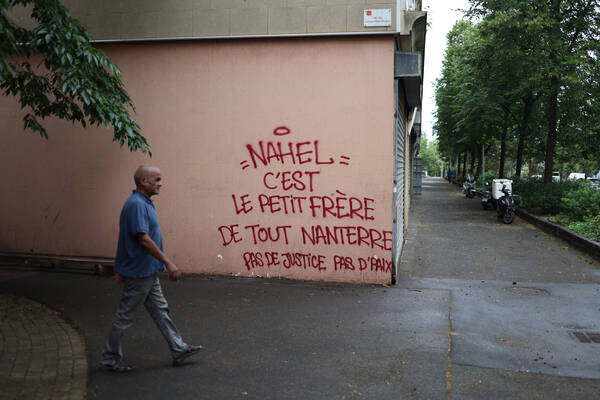France: Racist police incites massive youth rebellion
During a traffic stop by two motorcycle cops in the Paris suburb of Nanterre June 27, one of the cops shot and killed a young driver, Nahel M., born in France of North African descent. The cops’ story tried to justify the killing using the pretext that Nahel was using his car against them.

Graffiti reads: “Nahel is the kid brother of all Nanterre. No justice, no peace!”
Cops are protected by a French anti-terrorism law rammed through Parliament in 2017 and renewed in 2021. The cops’ version was quickly picked up and repeated by most corporate media. But a video from a passerby quickly exposed the police lies, and the video went viral. The oppressed youth who inhabit the French suburbs, their parents and progressive supporters believed the video and rejected the “official story.”
The following revolt had many similarities to the Black Lives Matter uprising that followed the murder of George Floyd in Minneapolis at the end of May 2020.
The regime showed its worry by its attempts to conciliate with the masses. The next day, President Emmanuel Macron and Prime Minister Élisabeth Borne both condemned the police killing as unjustified, even abhorrent. The prosecutor on the case kept the killer cop locked up on charges of voluntary manslaughter.
Remember that this is the same government that pushed its cops to use tear gas and rubber-coated bullets against the Yellow Vests in 2018-19 and to arrest and beat unionists and others protesting the pension cuts all this year.
But the regime failed to stop the protests against the killer cops from becoming angry and massive. The anger among the youth in the suburbs over the daily racism they confront was too strong to be deflected by political maneuvers. (In France, most suburbs are working-class communities, often populated by descendants of migrants from former colonies.)
In Nanterre, Lyon, Marseilles, Toulouse, Paris — large French cities — youth set fires, burned and looted stores, barricaded major streets and fought with the cops. By Day 3 three, most French cities of any size had been the scene of conflict between cops and protesters.
The protesters, who were mainly under age 25 — videos showed they included a large number of young women — used roman candles and firecrackers to throw at the cops. Police fired tear-gas grenades and rubber bullets. The spectacular light show looked like a military battle. The first night police deployed 10,000 armed officials, escalating to 45,000 after Night 3 of the revolt.
Cops brought out armored personnel carriers to sweep aside barricades and provide firing positions for sniper rifles by Day 3. The first four nights the cops had arrested nearly 4,000 people. Told to be more aggressive, on Day 5 the cops picked up over 1,000.
Condemnation of police violence
France’s parliamentary parties usually condemn violence of the oppressed. The left also condemns the cops. That was true in France this week too.
After six months of intense struggle over the pension cuts, however, one of the units in the major union confederation, the CGT (General Confederation of Labour), which was a major force in that conflict, had a stronger approach: “Nahel is a new tragic victim of the police and a system which permits police violence . . .
“Once again, a drama was needed to make this reality visible to everyone. This explosion of anger cannot surprise us. It is also fed by the growing poverty of a large segment of the population. . . . Daily the lack of these means cries out.” (cgteduc-versailles.fr, July 2023)
Some labor militants, recalling the struggle against the pension reform, plan to call for a general strike at the end of July against racism and police violence. (New York Times, July 1)

